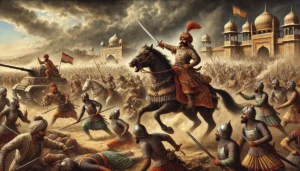Table of Contents
The Sikh community, facing continuous persecution, began organizing themselves into small armed bands. By 1748, approximately 65 such bands were consolidated into a larger, structured force known as the Dal Khalsa. Over the next two decades, this force evolved into 12 divisions, later known as Misls. Each Misl had a distinct name, leader, banner, and military strength.
The term “Misl” originates from an Arabic word meaning “equal,” reflecting the fundamental principle of equality within the Sikh divisions. Although each Misl had a chief, he was regarded as “first among equals,” embodying Guru Gobind Singh Ji’s philosophy of equal treatment for all. These Misls governed their respective territories while collectively resisting Afghan invasions and retaliating against Mughal atrocities. Despite having individual forces ranging from 2,000 to 15,000 soldiers, they could unite over 70,000 troops when needed.
Misls derived their names from their leaders’ customs or places of origin. For example, the Bhangi Misl was named after its leader’s consumption of bhang (cannabis). However, with time, internal conflicts arose among the Misls as personal ambitions took precedence over unity. From 1767 to 1799, Punjab remained under Misl rule until Maharaja Ranjit Singh unified and consolidated these independent factions, establishing his empire in 1801.
Political History of the Misls
Major Sikh Misls
| Misl | Capital | Founder | Estimated Strength |
| Faizalpuria (Singhpuria) | Jalandhar | Nawab Kapur Singh | 5,000 |
| Ahluwalia | Kapurthala | Jassa Singh Ahluwalia | 10,000 |
| Bhangi | Amritsar | Hari Singh | 10,000 |
| Ramgarhia | Sri Hargobindpur | Jassa Singh Ramgarhia | 5,000 |
| Kanhaiya | Sohian | Jai Singh Kanhaiya | 8,000 |
| Sukerchakia | Gujranwala | Charhat Singh | 5,000 |
| Phulkian | Patiala, Nabha, Jind | Chaudhary Phul | 5,000 |
| Dallewalia | Rahon | Gulab Singh Rathore | 5,000 |
| Nishanwalia | Ambala | Dasaundha Singh | 2,000 |
| Karor Singhia (Panjgarhia) | Shamchaurasi, Hariana | Karora Singh | 10,000 |
| Shaheedan (Nihang) | Shahzadpur | Baba Deep Singh | 5,000 |
| Nakai | Chunian | Hira Singh Nakai | 7,000 |
Administrative Structure of the Misls
The Misls had a decentralized governance structure with four main administrative systems:
1. Patadari System
- Applied to newly annexed territories.
- The Misl chief allocated land among Sardars, who further distributed it among Surkundas (leaders of small cavalry units) and their soldiers.
- Land could not be sold but could be inherited.
2. Misaldari System
- Applied to Sardars with smaller cavalry forces.
- They retained control over lands they held before joining the Misl.
- Leaders, known as Misaldars, could switch allegiance and transfer land between Misls.
3. Tabadari System
- Land grants were given to Tabadars in return for military service.
- Tabadars were subordinate to the Misl chief and had no permanent ownership rights.
- Grants could be hereditary only at the discretion of the chief.
4. Jagirdari System
- Jagirs (land grants) were given to relatives, dependents, or meritorious individuals.
- Jagirdars were required to use their land’s revenue to maintain cavalry forces.
- While hereditary in practice, a Misl chief could revoke an heir’s right to a Jagir.
Decline of the Misls and Rise of Maharaja Ranjit Singh
The Misls played a crucial role in resisting external forces, but their internal rivalries weakened them. After the Mughal and Afghan threats diminished, conflicts among the Misls intensified as they vied for territorial expansion. This fragmentation made them vulnerable to external influence and internal power struggles.
By the late 18th century, Ranjit Singh, the leader of the Sukerchakia Misl, emerged as a unifying force. Through strategic alliances, diplomatic marriages, and military conquests, he consolidated the various Misls under his rule. By 1801, he established the Sikh Empire, marking the end of independent Misl rule and the beginning of a unified Punjab under his leadership.
The Sikh Misls were instrumental in shaping Punjab’s political and military landscape. While they initially thrived on principles of equality and collective resistance, their eventual downfall stemmed from internal conflicts and ambition-driven rivalries. Despite their decline, their legacy lived on through the formation of the Sikh Empire under Maharaja Ranjit Singh, who successfully unified Punjab and strengthened Sikh sovereignty.
| Punjab PCS Important Links | ||
| Punjab PCS Notification | Punjab PCS Apply Online | Punjab PCS Syllabus |
| PPSC Eligibility Criteria | PPSC PYQ | Punjab PCS Notes |


 Buddhism History, Origin, Sect, Councils...
Buddhism History, Origin, Sect, Councils...
 Rana Sanga: The Fearless Rajput King and...
Rana Sanga: The Fearless Rajput King and...
 Vikramshila University Revival, Location...
Vikramshila University Revival, Location...













